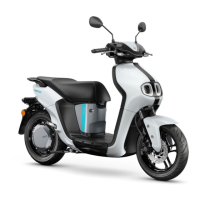
Do you have a question about the Yamaha NEO'S ESS025 2022 and is the answer not in the manual?
| Category | Electric Scooter |
|---|---|
| Battery | Lithium-ion |
| Battery Capacity | 50.4V, 19.2Ah |
| Max. Speed | 45 km/h |
| Seat Height | 795 mm |
| Front Brake | Disc |
| Rear Brake | Drum |
| Motor | Brushless DC Motor |
| Charging Time | Approx. 8 hours (0-100%) |
Owner's responsibility for safe operation and required qualifications.
Advice for safe operation, vehicle control, and hazard avoidance.
Requirements for rider protective gear like helmets and clothing.
Guidelines for adding accessories and cargo to maintain stability.
Precautions for tire condition and safe vehicle transportation.
Warnings for specific riding conditions like wet roads and intersections.
Identification of parts on the left side of the vehicle.
Identification of parts on the right side of the vehicle.
Location and function of handlebar controls and dashboard instruments.
Illustration and naming of the battery charger and lithium-ion battery.
Diagram showing the location of major high-voltage EV system components.
General description of the ESS025 electric commuter vehicle.
Warnings and precautions for high voltage components and wiring.
Explanation of installing and using up to two lithium-ion batteries.
Information on charging the 12V battery and estimated travel distance.
Explanation of drive modes and EV system temperature warnings.
Description of how the regenerative brake works and its limitations.
How to check the battery level using various indicators.
Guidelines for effective battery use and CCU functionality.
Steps for pairing the CCU with a smartphone via the MyRide App.
How the smart key system works for vehicle operation and theft prevention.
Information on the smart key system's operational range and usage tips.
Proper handling of smart keys, mechanical keys, and ID cards.
Information on smart key battery life, replacement, and registration.
How to use the remote answer-back function and manage its beeper.
Procedures and precautions for replacing the smart key battery.
Description of the main switch knob positions and their functions.
How to turn the vehicle power on and off using the main switch.
How to open the seat and open position reminders.
How to lock and unlock the steering using the main switch.
Operation of the main switch for ignition, lighting, and steering lock.
How to open and close the keyhole shutter for access.
Explanation of various indicator and warning lights on the dashboard.
Components and functions of the multi-function display.
How to switch display units between kilometers and miles.
How the speedometer and odometer work and their limitations.
How battery level and other information are displayed.
How to reset the trip meter and understand vehicle status messages.
Explanation of incoming notification and call icons.
Function of charging indicator and handlebar controls.
Operation of horn, mode, and run switches.
How to use the front and rear brake levers.
How to open the seat and use helmet holders.
Description and capacity of the vehicle's storage compartments.
How to use and retract the luggage hook.
How to use the power outlet and the function of the sidestand.
Inspection points for the front brake system.
Inspection points for the rear brake and control cables.
Inspection of wheels, tires, and brake levers.
Checks for chassis fasteners, instruments, lights, and switches.
Inspection of lights, switches, and the sidestand switch.
Warnings about handling the battery charger to prevent shock or fire.
Precautions for handling the lithium-ion battery to avoid shock or fire.
Guidelines for safe and efficient charging environments and steps.
Information on charging time and how to monitor charging status.
General battery information, degradation, recycling, and disposal.
Technical specifications for the battery charger and battery.
Steps to take before starting the vehicle, including sidestand checks.
How to start the vehicle and begin riding, including indicator checks.
How to control speed and brake effectively.
Instructions for parking the vehicle securely and safely.
Location of the vehicle's tool kit.
A schedule of periodic maintenance tasks based on mileage.
How to check accelerator grip free play and tire condition.
Procedures for inspecting tires and understanding tire information.
Information on tire aging and cast wheel care.
How to check and adjust brake levers and cables.
How to check brake pad and shoe wear indicators.
Procedures for checking and changing brake fluid.
Guidance on lubricating control cables and accelerator grip.
Lubrication points for brake levers, centerstand, and sidestand.
How to inspect the front fork and steering system.
Procedures for checking wheel bearings and the 12V battery.
Steps and precautions for replacing vehicle fuses.
Information on vehicle lights and basic troubleshooting steps.
Guidance for diagnosing and resolving common vehicle problems.
Steps to diagnose and resolve issues with the smart key system.
How to operate the vehicle in emergency mode without the smart key.
Advice on cleaning matte finished parts to avoid damage.
Detailed steps for washing and cleaning the vehicle.
Steps to take after washing, including drying and polishing.
Instructions for storing the vehicle properly, including tire care.
Guidelines for storing the lithium-ion and 12V batteries long-term.
Key physical dimensions and weight specifications of the vehicle.
Specifications for the power unit, tires, and braking system.
Specifications for suspension, main battery, and lighting.
Where to find and record vehicle identification numbers.
Location of the model label and diagnostic connector.
Information on vehicle data storage and Yamaha's privacy policy.
